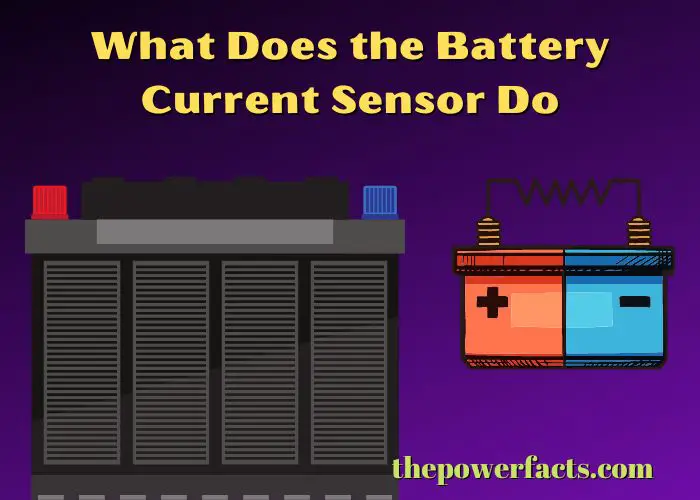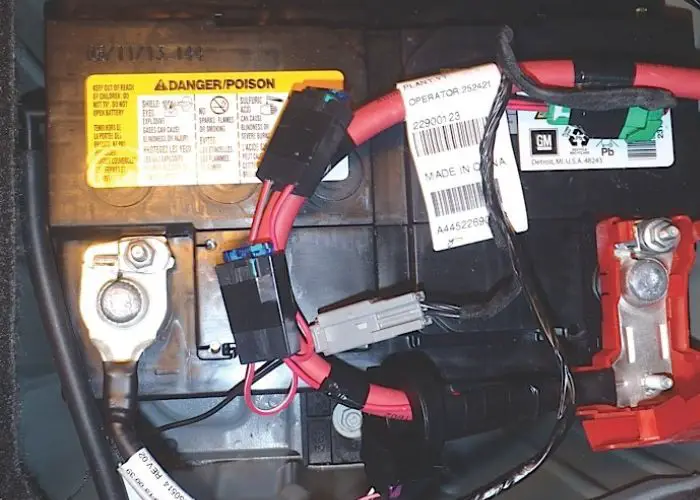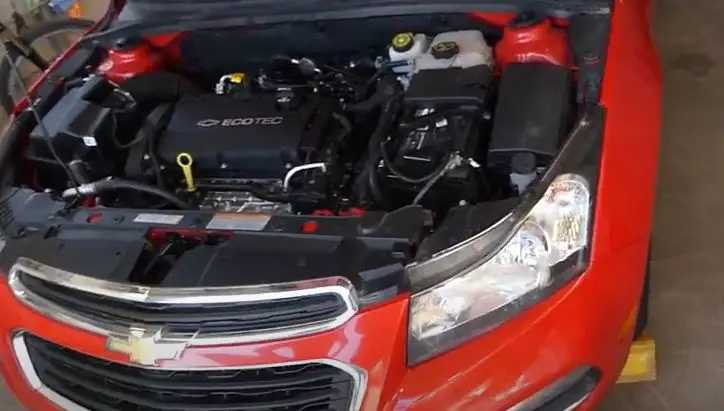The battery current sensor is a device that measures the current flowing in and out of a battery. It is used to monitor the health of the battery, as well as to optimize charging and discharging cycles. By measuring the amount of current flowing into or out of the battery, the sensor can track how much charge is remaining in the battery.
This information can be used to prevent overcharging or deep discharge, which can damage the battery.

As its name suggests, the battery current sensor measures the current flowing in and out of the battery. This information is then used by the car’s computer to determine how much power is available, and how it is being used. The sensor is located near the battery and consists of a small coil of wire that produces a magnetic field.
This field is interrupted by the flow of current, which produces a change in voltage that can be measured by the computer.
How Do I Know If My Battery Current Sensor is Bad?
If your vehicle’s battery current sensor is bad, there are a few things that you can look for to diagnose the problem.
| First | If your vehicle’s battery light is on or flickering, this is an indication that the current sensor is not working properly. |
| Second | Additionally, if your vehicle’s voltage gauge is reading higher or lower than normal, this could also be an indication of a problem with the current sensor. |
| Finally | If your car is having trouble starting or staying running, this could be another symptom of a bad current sensor. If you notice any of these issues, it is best to take your car to a mechanic or automotive specialist to have the problem diagnosed and repaired. |
Is the Battery Current Sensor Important?
Most people don’t know that their car has a battery current sensor. This sensor is important because it helps to protect your car’s battery from being overcharged. When your car’s engine is running, the alternator produces electricity that charges the battery.
The battery current sensor monitors the amount of current flowing into the battery and prevents the alternator from overcharging it. If your car didn’t have this sensor, the alternator could damage the battery by overcharging it. The battery current sensor protects your investment in the battery and ensures that it will last for many years to come.

Can You Bypass Battery Current Sensor?
Yes, it is possible to bypass the battery current sensor. This can be done by connecting a wire from the positive terminal of the battery to the positive terminal of the load and then connecting a wire from the negative terminal of the load to the negative terminal of the battery. This will bypass the current sensor and allow for higher currents to flow through the circuit.
What is the Purpose of a Battery Sensor?
If you want to know what is the purpose of a battery sensor? A battery sensor is a device that monitors the charging and discharging of batteries. It provides feedback to the user or system about the current state of the battery and can be used to optimize power usage. Battery sensors can be used in a variety of applications, including mobile devices, electric vehicles, and energy storage systems.
What Happens When a Battery Current Sensor Goes Bad?
When a battery current sensor goes bad, it can have a big impact on the performance of your vehicle. The most common symptom of a bad battery current sensor is a drop in fuel economy. Other symptoms can include a loss of power while accelerating, and your engine may run roughly when idling.
If you suspect that your battery current sensor is going bad, it’s important to have it checked out by a professional as soon as possible.
Battery Current Sensor Test
The purpose of a battery current sensor test is to determine the amount of current flowing through a battery. This information can be used to help determine if the battery is charging or discharging properly. There are a few different ways to test for current flow in a battery.
Use a Multimeter
One common method is to use a multimeter. First, you’ll need to set the multimeter to measure the DC current. Then, you’ll need to connect the positive lead of the multimeter to the positive terminal of the battery, and the negative lead of the multimeter to the negative terminal of the battery. Once connected, you can take a reading of the current flow.
Test for Current Flow is by Using an Ammeter
Another way to test for current flow is by using an ammeter. An ammeter is specifically designed for measuring electrical currents, so it’s more accurate than using a multimeter.
To use an ammeter, you’ll again need to connect the positive lead of the ammeter to the positive terminal of the battery and then attach the negative lead directly onto one of the wires leading from the negative terminal of the battery (this will complete the circuit). Once connected, you can take a reading of the current flow. No matter which method you use, it’s important to keep in mind that any time you’re working with electrical components there’s always a danger of an electrical shock so work carefully and consult with an expert if you have any questions or concerns about testing your own batteries!
GM Battery Current Sensor Problems
If you own a GM vehicle, you may have experienced problems with the battery current sensor. The sensor is located in the battery compartment and monitors the current flowing in and out of the battery. If there is a problem with the sensor, it can cause the battery to overcharge or discharge prematurely.
In some cases, it can also cause the engine to stall. If you’re experiencing any of these problems, it’s important to take your vehicle to a qualified service center for diagnosis and repair. In most cases, replacing the battery current sensor will solve the problem.
How do Bypass Battery Current Sensors?
If you want to bypass the battery current sensor in your car, there are a few things you’ll need to do.
| 1 | Disconnect the negative terminal of your battery. |
| 2 | Locate the fuse box and remove the fuse for the battery current sensor. |
| 3 | Reconnect the negative terminal of your battery and start your car. |
Battery Current Sensor Location

If your car has a battery current sensor, it is likely located near the battery. This sensor monitors the current flowing in and out of the battery and sends this information to the car’s computer. The computer uses this information to help regulate the charging system and prevent overcharging.
GM Battery Current Sensor Bypass
If you have a GM vehicle and want to bypass the battery current sensor, there are a few things you need to know.
| First | The battery current sensor is located on the negative side of the battery. |
| Second | You’ll need to remove the battery terminal from the negative side of the battery. |
| Third | Once you’ve done that, you can simply bypass the sensor by connecting a wire from the positive side of the battery to the negative side. |
Battery Sensor
A battery sensor is a device that monitors the voltage and current of a battery. It can be used to measure the charge level, discharge rate, and capacity of a battery. A battery sensor can also provide information about the health of a battery, such as its temperature and internal resistance.
Battery sensors are used in a variety of applications, including electric vehicles, consumer electronics, and industrial equipment. They are often integrated into battery management systems (BMS), which monitor and control the charging and discharging of batteries. There are many different types of battery sensors on the market today.
Some common features include
• Voltage Monitoring
This measures the voltage across all cells in a battery pack. It can be used to determine when a cell is overcharged or discharged.
• Current Monitoring
This measures the current flowing into or out of a battery pack. It can be used to regulate charging and discharging rates.
• Temperature Monitoring
This measures the temperature of individual cells in a battery pack.
It can be used to prevent overheating during charging or discharge cycles.
Last Remarks
The battery current sensor is a device that measures the current flowing in and out of a battery. It is used to monitor the charging and discharging of batteries, and to protect against over-current conditions. The sensor consists of a sensing element and an amplifier.
The sensing element is typically a resistor or a coil of wire, and the amplifier is an operational amplifier.